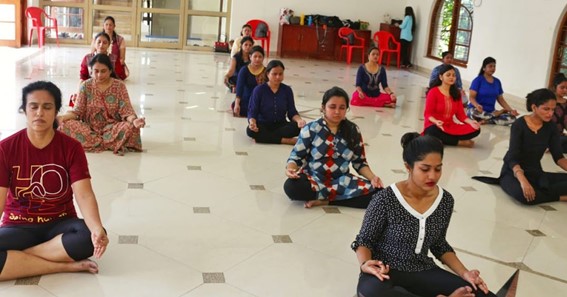Choosing the right yoga teacher training program is a crucial step on the path to becoming a skilled and authentic yoga instructor. With numerous options available, it can be overwhelming to identify the most suitable program that aligns with your aspirations and learning goals. In this blog, we will explore the key factors to consider when selecting a yoga teacher training course, ensuring you make an informed decision that will lay the foundation for a successful and fulfilling teaching journey.
Accreditation and Certification
The first and foremost aspect to look for in a yoga teacher training program is accreditation and certification. Seek a program that is recognized and certified by reputable yoga organizations, such as the Yoga Alliance. Accreditation ensures that the training adheres to specific standards and guidelines, ensuring you receive a comprehensive education that covers the essential elements of yoga philosophy, anatomy, asanas (poses), meditation, and teaching methodology.
Experienced and Knowledgeable Instructors
The expertise and experience of your yoga teacher training instructors play a pivotal role in shaping your learning journey. Seek out certified teachers with a strong background in practicing and teaching yoga. Seasoned instructors not only excel in knowledge transmission but also offer valuable mentorship, empowering you to grow into a skilled and self-assured yoga teacher, ready to make a positive impact on your students’ lives.
Comprehensive Curriculum
A well-rounded curriculum is essential for a yoga teacher training program. It should include a balanced combination of theoretical and practical components. Some crucial topics to consider in the curriculum are:
a. Yoga Philosophy: Understanding the ancient yogic texts, such as Patanjali’s Yoga Sutras, and exploring the spiritual aspects of yoga.
b. Anatomy and Physiology: Learning about the human body, its systems, and how yoga postures affect different muscles and organs.
c. Asanas: In-depth study and practice of yoga poses, their alignment, variations, and modifications.
d. Meditation and Pranayama: Techniques to cultivate mindfulness and control of breath.
e. Teaching Methodology: Effective teaching techniques, communication skills, and class sequencing.
f. Practicum: Opportunities to gain teaching experience under the guidance of experienced instructors.
Class Size and Student-Teacher Ratio
Opting for a yoga teacher training program with a small class size and low student-teacher ratio offers numerous advantages. Personalized attention and an intimate learning environment enable deeper student-instructor interactions, encouraging open discussions, and individualized feedback. This supportive atmosphere nurtures a sense of belonging, fostering a conducive space for both personal growth and refining teaching abilities. In such settings, aspiring teachers can build strong connections with their mentors, fostering a sense of community and elevating the overall learning experience.
Practical Experience and Teaching Opportunities
A well-rounded yoga teacher training program should provide abundant practical experience and teaching opportunities. Engaging in practical sessions and teaching real students allows you to apply acquired knowledge and develop confidence as an instructor. Hands-on experience is invaluable for honing teaching skills, empathetically comprehending student needs, and adeptly managing diverse groups. This practical exposure fosters a profound connection between theory and application, ensuring you are fully prepared to lead inspiring and transformative yoga classes. Embrace these opportunities to blossom into a skilled and compassionate yoga teacher, ready to make a positive impact on your students’ lives.
Yoga Styles and Specializations
Yoga boasts a rich tapestry of styles, each tailored to diverse preferences and requirements. When selecting a teacher training program, prioritize those that expose you to a wide array of yoga styles, including Hatha, Vinyasa, Ashtanga, Yin, and Restorative, among others. By diversifying your knowledge and skills, you become a versatile and adaptable yoga teacher, adept at addressing the unique needs of a broader spectrum of students.
Moreover, some training programs offer specialized courses in areas like prenatal yoga, yoga for seniors, or trauma-informed yoga. Deliberate on whether pursuing such specializations aligns with your passions and long-term aspirations. These focused trainings can bestow you with invaluable expertise, allowing you to serve specific populations with compassion, understanding, and proficiency. Embrace the opportunity to become a well-rounded yoga instructor, equipped to cater to diverse communities and spread the transformative power of yoga far and wide.
Reviews and Testimonials
Before enrolling in a yoga teacher training program, conduct thorough research on the experiences of former students. Seek out reviews and testimonials online or reach out to program graduates to glean insights into their training journey. Favorable feedback from past participants can instill confidence in the program’s overall quality and effectiveness. Hearing firsthand accounts from those who have walked the path before you can help you make an informed decision, ensuring your investment in the training is fruitful and aligns perfectly with your aspirations as a future yoga instructor. Take the time to gather these valuable perspectives, empowering yourself with knowledge to embark on a transformative learning adventure.
Location and Schedule
When selecting a yoga teacher training program, practical considerations like location and schedule hold significant importance. Ensure the program’s location is convenient and meets your needs. If it involves travel, factor in additional costs and time commitments. As for the schedule, options range from intensive formats that demand full-time dedication for a shorter duration to extended courses spread over several months. Opt for a schedule that harmonizes with your lifestyle and commitments, granting you the necessary time and focus to immerse yourself fully in your training. Striking this balance will enable you to make the most of your transformative learning experience while maintaining a harmonious life rhythm.
Conclusion
Selecting the right yoga teacher training program is a pivotal step in your journey to becoming a skilled and authentic yoga instructor. Prioritize accredited and certified programs, led by experienced instructors and offering a comprehensive curriculum that includes both theoretical and practical aspects. Consider class size, teaching opportunities, and the availability of diverse yoga styles and specializations. Don’t forget to read reviews and testimonials from previous students and ensure that the location and schedule suit your needs. With careful consideration, you can embark on a transformative and rewarding yoga teacher training experience that sets the stage for a successful career in guiding others on their yoga journeys.
Click Here – The Power of Accredited Digital Marketing Courses: Why Traditional Marketing is Outdated






